Sump pump working really hard, at new 22 James St. severed-lot building in Long Branch
I am pleased to share with you (for purposes of discussion) the following message from Brian Liberty of Long Branch:
Dearest staff of Municipal Licensing and Standards,
It seems the problem child at 22 James and its ugly brother to the east have been passed along to your laps now – kindly see attached. On Saturday, February 25th, I watched as this sump pump pipe consistently shot out a stream of water for well beyond the five minutes I was speaking with a neighbour out front. It’s a shame the rivers flowing under our Long Branch homes couldn’t stay underground. One hopes the new owners will have a backup battery/generator and a great flood insurance policy.
Unfortunately the issue renders itself null at the Committee of Adjustment and Ontario Municipal Board with respect to potential drainage or broader neighbourhood flooding issues. Most often, the Board Chair at a hearing will take the time to acknowledge the lack of any other comments by Toronto Water staff beyond standard engineering comments. These applications need additional language from other departments with jurisdiction and professional designation to address the water issues. Permeable pavers are not sufficient to address front yard landscaping drainage when a dwelling has been approved at 80 or event 100 percent increase in density of the bylaws.
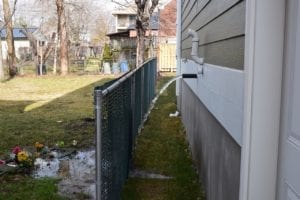
Sump pump in operation on west side of 22 James St. Polling of water from the water discharge is evident at backyard of 26 James St. Jaan Pill photo
The Long Branch ecosystem cannot handle the size of residential dwellings being approved at the C of A and OMB. But the building permits have been signed off. Another house sold, another civil lawsuit born.
Kind regards,
Brian Liberty
Long Branch resident
Interim Chair, Long Branch Neighbourhood Association
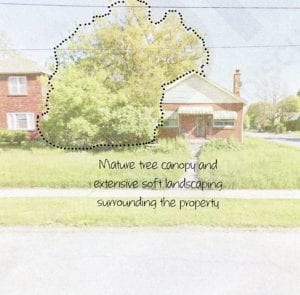
Figure 88: Generously planted corner property before development. (Topic: Before & After Analysis.) [The location is 20 James St. at James St. & Thirty Seventh St.]
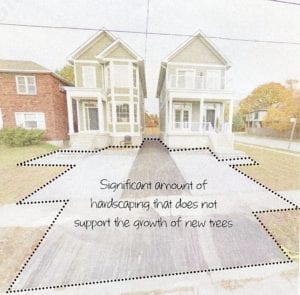
Figure 89. Curb cuts and hardscaped driveways associated with severed lot (Topic: Before & After Analysis.) [The location is 20 & 22 James St. at James St. & Thirty Seventh St.]
Additional reference to severed lots at 20 James St.
The severed lot at 20 James St. is highlighted at the following recent post concerned with the Feb. 7, 2017 Long Branch Guidelines Draft.
I have added some photos of my own, regarding 20 & 22 James St., by way of continuing the narrative concerned with the destruction of soft landscaping.
If you look at the backyards of the two severed lots, you will note that much of the backyard space has been devoted to pavement.
In terms of the larger narrative, part of the story that we are focusing upon concerns the OMB.
Click here for previous posts about the OMB >
A recent post in this series is entitled:
Among much earlier posts is one entitled:
As is noted at the above-mentioned March 7, 2015 post (that is, a post from two years ago), I attended the Feb. 13, 2015 OMB meeting concerned with 20 James St.
The meeting brought to mind, for me, the fiction of Franz Kafka as we’ll as the history of the British empire. as I noted at the post:
When I observe OMB hearings, among the scenarios that come to mind are the stage settings and pronouncements associated with the history of the British empire. What transpires at OMB hearings, as the OMB is currently constituted, is of much interest to any person who cares about the governance of the City of Toronto or who has an interest in live theatre. The literary works and office writings of Franz Kafka (1883-1924) also come to mind, along with a wide range of evocative historical references, when a person attends meetings of the OMB.
OMB meetings are open to the public. Any person can attend such a meeting as an observer, in order to view what transpires at such meetings.
I encourage City of Toronto high school teachers, who are teaching History and Civic Engagement and similar academic subjects, to bring groups of students to observe OMB meetings related to planning issues in local communities.
Do we live in a civil society, or in a “failed state”?
Whether or not the society in which we live can legitimately be characterized as a civil society is an interesting topic, which is, perhaps, open to debate. This is a thought that may come to mind when a person attends an OMB meeting.
It has been my experience that, on some occasions, local residents who appear at OMB hearings are treated with respect.
It has also been my experience – for example, at the OMB hearing related to 20 James Street – that local residents appearing before the Board have, on occasion, been treated with a level of disrespect that is not characteristic of civil society. Such behaviour, on the part of a number of OMB officials, warrants documentation.
I encourage the documentation of such behaviour, with a focus on accurate and balanced sharing of information related to what transpires from moment to moment at such meetings. Such behaviour is, in my view, a key part of the unfolding history of urban planning at the City of Toronto.
David Godley shared the following evidence at the Feb. 13, 2015 OMB hearing regarding 20 James Street; the OMB decision was in favour of the development
Below is an excerpt from the evidence that David Godley shared at the Feb. 13, 2015 OMB hearing. To view the complete text of what he shared, please click here.
Recent approvals in Long Branch: continuation of text from David Godley for Feb.13, 2015 OMB hearing
21) Recent approvals in Long Branch provide examples of taking one type of development somewhere in the neighbourhood and transposing it to another site. (Appendix D). One house owner has their rear windows completely darkened (this also shows that 2 feet side yard set back is unworkable), another is so overshadowed that the owner sold up and another has their view, light and sunlight diminished by an overwhelming wall.
Any person passing by can see the development sticks out like a sore thumb in terms of massing and spacing because the lots are so narrow and with the increase in density from 35% to 53% (in the subject case) about 50% larger than currently permitted. “Nearby massing” referenced in the OP is a key element of compatibility and relates strongly to lot frontage and density.
22) Although residents, as experts on the neighbourhood, often plead to have their concerns taken into account there is no evidence they did in a number of approvals. Decisions were sometimes based on “expert opinion” from development planners.
However the 2011 20 James severance was turned down despite expert evidence from a development planner and with no expert opposition evidence. In 2011 the OMB member concluded that a severance on this site was contrary to the OP because it did not accord with the character of the neighbourhood. (pl 110241)
23) Once applications are made they have to conform to the Official Plan in all aspects such as impacts on neighbours, preservation of trees and of course neighbourhood character.
24) OP policies (Section 3.1.3) require that new development be “massed and its exterior façade will be designed to fit harmoniously into its existing and planned context”. It has policies on protecting light, sunlight and privacy. In addition the intent of the zoning bylaw would be to protect views and overpowering walls. OP Section 3.1.1d requires enhanced public realm and encourages use of skilled professionals for design which does not appear to be the case here.
The proposed houses are not architect designed. Section 3.4.1d includes a policy to increase the tree canopy. Managing groundwater infiltration is important (Section 3.4.2) as wet basement problems are common in this neighbourhood with underground streams. The proposal with its shared driveway right into the rear yard and parking at the front fall foul of this policy. If trees are to be lost this aggravates the situation.
25) An important aspect of a planning decision is support or opposition from the local community. Within the City planning framework citizens should have some power to shape their neighbourhood.
This is simply good planning as opposed to a top down, authoritarian, technocratic, elitist approach. Planning is an art and science.
Click on the photos to enlarge them; click again to enlarge them further
If the local community support the application, along with the Committee of Adjustment and agencies, all is well and good. If they do not support it, weight needs to be given to their thoughts and feelings about their area to allow some control over the future of their neighbourhood in which they live.
Residents have made probably the largest investment in their life in a house and it is imperative to have their own property rights protected. Thus there is a fair balance between local and citywide interests.
26) The developer’s role is implementation rather than policy maker.
27) The planning tenet of “localism” has been invoked nationally in English planning and is implemented by Community Boards in New York. The stakeholders have a greater control in the neighbourhood than the developer whose job is to bring a plan to fruition. However the development industry’s role is essential in bringing about implementation within the legal and planning framework of the overall community.
City of Hamilton
28) The City of Hamilton (Appendix B) follows this approach through Neighbourhood Plans. City of Hamilton planning philosophy is that decisions should be made on issues as close to the impact level as possible. Mississauga is using citizen led planning with success in Lakeview, to the west of Long Branch. The balance between City wide interests and those locally impacted is central to good planning. This is public participation or civic engagement which all professional planners support. This is endorsed by the Planning Act and Official Plan through notification and public meeting requirements.
29) The applicant is asked on forms why the proposals cannot meet the current criteria. There is no reason to change the current planning requirement as the lot is intended for detached house. The real answer is to make more money. It would be simpler to build a single house like the builder at 27 33rd Street was persuaded to do. This gives a good example of infill.
30) I have demonstrated that I am not anti development and have been consistent all my career with neighbourhood character evaluation.
31) In contrast, the development planner has a direct and indirect pecuniary interest. The applicant pays the planner and if successful will get more commissions. One planner acting for a developer had been found guilty by the Divisional Court of breaking his professional planning code and fined $30,000 but still his evidence overruled anything anyone else had to say. Membership of professional associations is not necessarily the defining issue because the defence that “it is my opinion” cannot be refuted. The unaccountable development planner therefore may look for a way to try to bypass official policy by emphasising certain aspects and skimming over other aspects.
32) Professional membership of a planning association does not automatically imply expert status. Planners have specialisms just like doctors. A dermatologist would not give an expert advice on oncology. It is training and experience that are the determinants. I have had meetings with the planner representing this developer and he has little grasp of urban design and I doubt any training. The superficial determination that a member of CIP is automatically an expert planner is erroneous and has resulted in approval decisions misconstruing the Official Plan policies and good planning.
33) I was privileged to be on the Committee of Adjustment when we were briefed by City Planners on the policies and intent of the OP and had to apply the OP policies to many applications. I am also aware of the process in finalising the Official Plan where many negotiations took place to improve the wording, particularly on character criteria.
34) The Etobicoke Official Plan used the words “neighbourhood fit” and “compatibility”. The Official Plan sought to strengthen the wording and did so after careful consultation and consideration. Nobody anticipated the bizarre angle of the developer’s planner. The current Official Plan is being undermined by inappropriate approvals. Every inappropriate approval has the double impact of incompatible housing and encouraging more.
35) The Etobicoke Plan was strong enough to have 32 33rd Street severance turned down. The City used my basic way of evaluating neighbourhood character. This is to take a smaller area that can be seen clearly from the front of the subject property rather than large meaningless study area. Planners involved in the current review of the OP are likely to be including my basic process for evaluation for clarification as they have had many qualified people telling them to do this to block the loophole created by imaginative development planners.
36) The way the development planners do this is to draw an arbitrary study area containing 100s of houses. Then they say that if there is a similar property in the study area it conforms to the Official Plan. This demonstrates a basic misunderstanding of neighbourhood character. It is irrational because based on this assumption (2) 3 storey houses, a triplex, or a store can be built anywhere in the neighbourhood which they define in their study area. Basically any neighbourhood use would be appropriate according to them. There are also tall towers in the neighbourhood, a large area of 7 storey blocks at the lakeside as well as lower rise apartments. These also have no bearing on analysis for neighbourhood character for the subject lot but might well be included and even be prevailing in the arbitrary large neighbourhood study area.
37) Section 4.1.5 of the OP states “Development in established Neighbourhoods will respect and reinforce the existing physical character of the neighbourhood.” In the OP Review, to ensure this means a realistic neighbourhood, discussion has been around adding “geographic” to ensure that it is not just part of the neighbourhood such as a study area.
South Long Branch
38) South Long Branch is the relevant neighbourhood as it has common schools, parks and commercial strip along Lake Shore Boulevard. It is one of the best physically defined areas in the City. The now dormant neighbourhood association represented this area as Residents Association of South Long Branch (Razzle). This is the area to which the community relate.
39) Size and configuration of lots is criterion b in Section 4.1.5 of the OP. An estimated over 75% of land use is lots of 40 feet (the zoning minimum) and over containing detached houses. (Appendix E shows the colours yellow, blue and purple dominating the neighbourhood.) A minimal number of lots containing various types of residential exist but the prevailing character (the key OP words) is overwhelmingly larger lots. Special built form features would be the cottages (criteria g) not the suburban narrow house.
40) Criterion c is “heights, massing and scale and dwelling type of nearby residential properties”. My underlining
41) Buildings fairly close but out of sight on other streets or sections of streets are basically irrelevant. The detailed neighbourhood character is formed from an amalgam of streets and sections of streets, particularly in Long Branch where there are contrasting characters. The most relevant area is the view of the neighbourhood as someone passes through it. A similar development around the corner does not mean it is appropriate because context would be different.
42) What matters is the nearby, traditional properties that you can see from the front of the property. Those closest are of greatest importance. It is the prevailing features which need to be reflected not the unusual or isolated example of development. The development must reflect the rhythm of the street rather some outlier development.
43) OMB decisions on 241 and 251 Golfdale Road, Toronto (pl 081436,121038) and 200 Keele Street, Toronto (pl 090507) confirm this relatively tight area of properties is appropriate and reject properties on the next parallel street as being influential to character
20 James
44) In the case of 20 James which fronts on James but has a side property line on 37th Street we have to look at both streets. 20 James Street is at the centre of an unbroken area of 50 feet frontage lots. All the lots around are 50 feet plus lots. Approval of this application will mean all these lots are ripe for splitting. This is termed blockbusting and can be seen in Alderwood. Most of the lots on 37th are 50 feet frontage lots and no severance has been granted for extra lots.
There are smaller lots on James Street towards 38th Street but these are mostly bungalows and all have low roofs as pointed out in the 20 James Street OMB decision. If most of the surrounding lots were 25 feet frontage and especially abutting properties, then a split would seem more reasonable. The approval of 4 James was a planning mistake as it was based on a development a good distance away and out of sight and even in a different zone.
45) The intent of the zoning bylaw is to have low density development with plenty of space around buildings and room for trees and vegetation. It also reduces the potential for overshadowing, overseeing and overbearing development. This is the reason why people move to South Long Branch. The approximately 50% increase of density does not comply with the intent of the zoning bylaws. The number of variances (14) attest to the overbuilt form. All the recent inappropriate approvals have been based on the fallacy that minor has the same meaning as major.
46) Variances need to be minor both in size and impact. See De Gaspris Divisional Court and 364 Lake Promenade (pl 110395-7) denial of severance. This again is something that has changed over time from a 10% guideline which reflects “small” the dictionary definition. No change has been made to the Planning Act.
47) Zoning is the planned development. The Official Plan requires both existing and planned development to be reflected and reinforced. 25 feet lot frontages do not reflect the zoning requirement of 40 feet frontage.
Nearby properties
48) Nearby properties have the following statistics and are compared to the proposal. Density strongly relates to mass and space.
Frontage in feet Density Planned Density
15 James 57 0.26 0.35
16 James 57 0.13 0.35
21 James 50 0.27 0.35
23 James 50 0.24 0.35
26 James 50 0.23 0.35
30 James 45.8 0.19 0.35
32 James 25 0.26 0.35
50 37th 50 0.17 0.35
54 37th 50 0.14 0.35
Average 43 0.22 0.35
20 James 25 0.53 0.35
(proposal) 25 0.54 0.35
49) The proposal exceeds planned density of the urban design character framework by about 65%. It exceeds existing density by 150%; lot frontage is lower by over 70%. None of these figures can be considered minor or have minor impact. There is a glaring disparity between the proposal and to both planned and existing development.
.
50) The massing of tall thin buildings is an opposite form to the wider lower buildings. The length of the buildings is much longer and because of the density increase, about 50% longer than permitted. The proposed house extends about 30 feet beyond the neighbour’s house at 26 James and 2 feet away from the property line giving negative impacts on sunlight, light, views and trees. Any blank wall on a detached house development would not need to project beyond the current next door house.
51) The prevailing character of the neighbourhood is larger lots of at least 50 feet wide. There are impacts on neighbours to the north which will be described by owners.
52) Apart from the severe rear yard impacts on especially 26 James, a facet of the proposal is one windowed blank wall on a corner about 50 feet long by 20 feet high. This will be the most intrusive wall in the neighbourhood. It will protrude towards 37th Street much further than the line of houses to the north (about 18 feet). No one with urban design sense would propose this in the middle of a neighbourhood. It is so extreme it would be reason in itself for turning the proposal down as it is out of character. It is proposed to be 2 feet away from the lot line when the new comprehensive zoning which is in force requires a set back of 10 feet.
53) There is inherent difficulty with the format of the proposal. A general movement away from mutual driveways has been made because of the joint use of the driveway and potential conflicts between neighbours e.g. blocking the driveway, maintenance, snow removal. Because of the narrow lane between houses owners tend to park at the front. 4 James is an example where 3 cars sometimes park on each parking pad and at the front on the entrance to the mutual driveway. Car dominated front yards with large areas of hard surface demeans the street character and decreases parking.
54) Trees need to be evaluated by the City before planning approvals are given. The idea of planning is to break down the silos and examine issues from an overall point of view. There is a large tree in the way of development and one on 26 James close to the boundary where development would take place. Without knowing the status of trees or impact on them the matter is premature. At 2 27th Street OMB approved a proposal subject to tree conditions. It was later found that 5 large healthy trees near the development would have to be removed. A critical situation was not evaluated.
55) Section 4.1.5 of the Official Plan requires “No changes will be made through the zoning bylaw, minor variance or consent that are out of keeping with the character of the neighbourhood”. The proposal is blatantly out of keeping. Any change must conform to the rest of the policies including impacts on neighbours (Section 3.1.2) and tree preservation (Section 3.4.1)
56) From the criteria in the Planning Act the proposal fails the following tests
a) This is a local matter and not of Provincial interest. There has been no Provincial input. Since the OP is consistent with the Provincial Policy Statements (PPS) and addresses density issues, the PPS is not relevant.
b) The proposal is premature because arboriculture has not been considered by the City as part of the review.
c) The City of Toronto OP policies are basically ignored and substantially transgressed
d) It is unsuitable for the proposed development but suitable for a detached house
f) The dimensions of the lots are too narrow. The 11 variances underline this.
57) The proposal is a major departure from both relevant zoning ordinances.
The proposal does not conform to the intent of the Official Plan.
The proposal is unsuitable and with creep/domino effect will lead to more unsuitable development.
58) The application fails all germane tests and criteria.
DAVID GODLEY, MA, MRTPI (Rt) Planning Consultant
401 Lake Promenade, Toronto, Ontario, M8W 1C3, Canada Tel 416 255.0492
[End of excerpt from David Godley’s evidence at Feb. 13, 2015 OMV hearing regarding 20 James St.]
*
Additional recent posts regarding OMB and Long Branch Guidelines Draft
Local Appeal Body for Toronto is still in process of being set up
Advisory Group for Long Branch Urban Design Guidelines had a productive meeting on Feb. 7, 2017
Culture of COA and OMB decision-making has changed dramatically in 25 years: MPP Peter Milczyn
What do you think is meaningful community consultation?


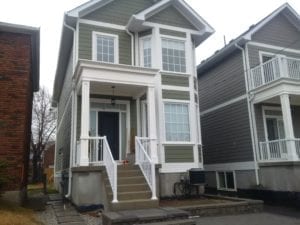


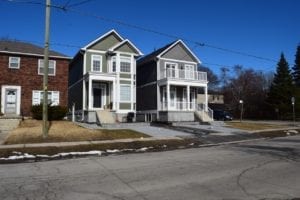
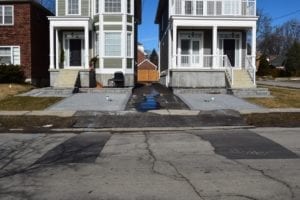


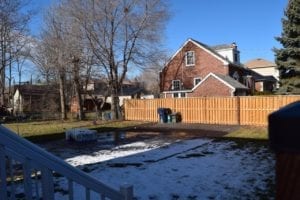
By way of an update:
A Feb. 28, 2017 Post City Toronto article is entitled: “The return of the parking pad as an issue is midtown neighbourhoods.”
Storytelling
I am pleased to add the following comment, related to storytelling:
We don’t know where the various initiatives (OMB Reform, Long Branch Guidelines, etc.) will go. We don’t know where this road leads.
What will come out of all this will mean different things to different people. An element of ambiguity will be built into whatever emerges, by way of new planning and community input scenarios, as is the case with any great work of art. There’s an element of suspense, an element of anticipation. All this makes for a great story. Brian Liberty’s story about the sump pump is a great addition to the narrative!